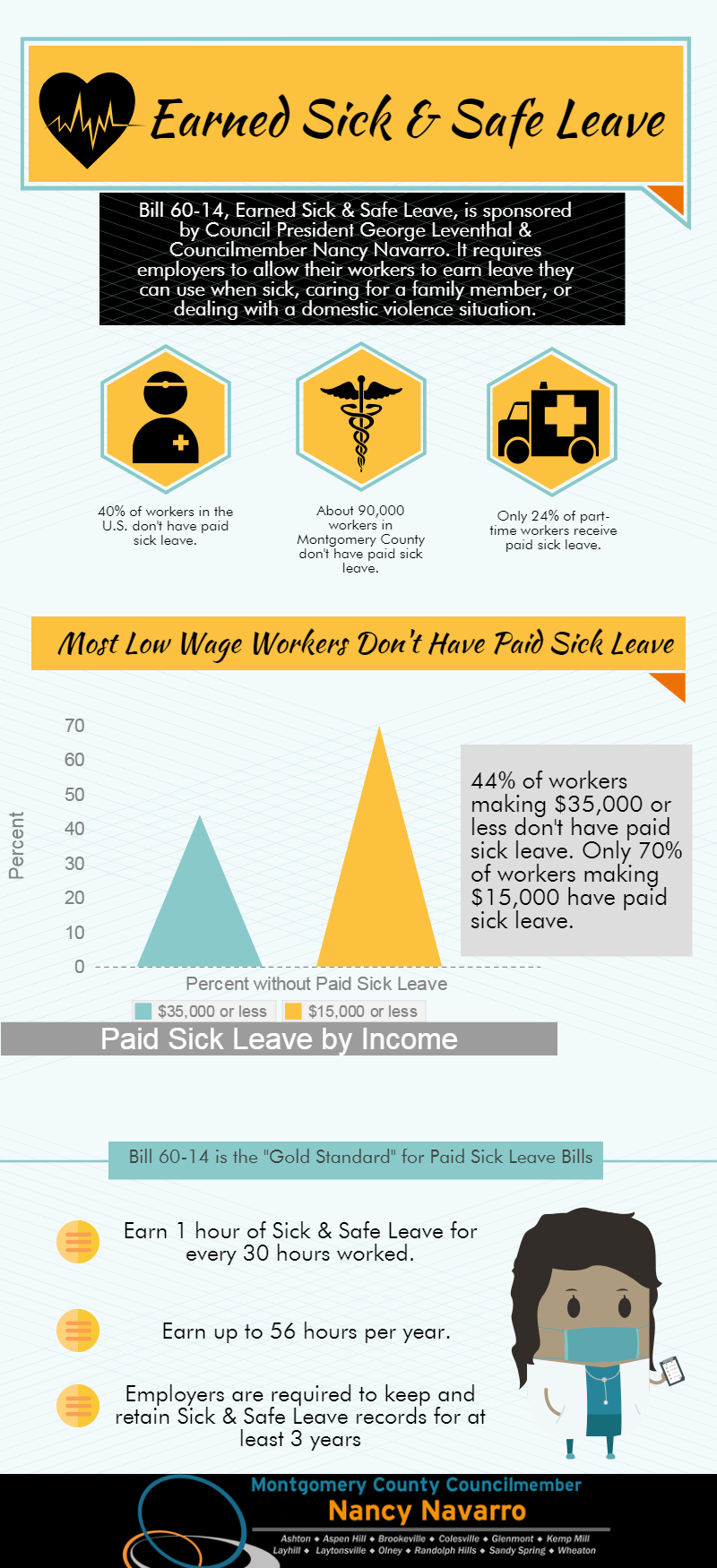Council Strengthens Living Wage Law Enforcement
ROCKVILLE, Md., February 2, 2016—The Montgomery County Council today unanimously approved legislation to significantly strengthen the enforcement of the County’s Living Wage law. Montgomery County service contractors are required to pay their workers a living wage set annually based on the rate of inflation. Bill 43-15 addressed concerns that that some employers were making deductions to their workers’ paychecks without the consent of the worker.
Possible violations of the living wage law were first reported by The Washington Post in May 2015. In October, lead sponsors Councilmembers Nancy Navarro and Marc Elrich introduced Bill 43-15. Councilmembers George Leventhal and Hans Riemer co-sponsored the bill.
The Post reported that approximately 140 governments nationwide have similar living wage laws to Montgomery County. That story can be found at http://tinyurl.com/gv765h3 .
The current living wage for employees working for contractors with Montgomery County is $14.35.
As approved, Bill 43-15 accomplishes the following:
- Requires detailed payroll records to be submitted quarterly to the Office of Procurement and requires the County to retain those records for at least five years.
- Establishes strong penalties, such as suspension and debarment, for a Living Wage law violation.
- Requires the County to perform regular and random audits and allows the County to recover costs for performing an audit as a result of an enforcement action.
- Prohibits an employer from making a deduction for any item necessary for an employee to perform the essential job function.
- Allows the County to withhold payment to a contractor found in violation of the Living Wage law.
- Removes the exemption in the Living Wage law for employees subject to collective bargaining agreements.
“I am pleased my colleagues unanimously supported this legislation to strengthen the County’s Living Wage law,” said Councilmember Navarro. “Montgomery County’s Living Wage law is designed to protect workers from abuses by employers and Bill 43-15 provides teeth to ensure the County can enforce it appropriately. Now, workers and the County will have recourse if an employer is not paying their employees fairly.”
Councilmember Elrich said: “In 2002, the Council passed a living wage bill with the clear intent to provide employees with a living wage. It is unfortunate that certain unscrupulous business owners managed to subvert the intent of the law, to the detriment of their employees. As amended today, the law now has clear reporting requirements and distinct penalties for not paying employees on County contracts a living wage. I am proud to stand with Councilmember Navarro and my colleagues in sending this clear message that the County will protect contractor employees’ right to earn a living wage.”
County Executive Ike Leggett will have 10 days to approve the bill after he receives it from the Council. The bill will take effect 91 days after it is signed by the County Executive.
# # # #
Improving the Procurement Process
This morning, the Government Operations and Fiscal Policy Committee reviewed the recommendations of the Procurement Policies and Regulations Task Force and the Minority Owned and Small Business Task Force. In October 2014, I proposed creating these task forces to review and evaluate Montgomery County’s procurement process. One of the complaints I hear from business owners of all sizes is that it is too difficult to do business with the County. People say the process takes too long, there is too much paperwork, and there isn’t enough communication with the Procurement staff.
The reason I supported creating two separate task forces is that the issues raised by business owners about procurement generally fall into two distinct categories. The first category focuses on process. The amount of time it takes to complete a request for proposals (RFP) or not having a formal debrief process after a contract is awarded were issues that could be solved by developing a new process for interacting with bidders. The charge of the Procurement Policies and Regulations Task Force was to holistically review the procurement process and recommend changes that would help businesses compete for contracts in Montgomery County.
The second category of concern raised by business owners was how small, minority, female and disabled-owned businesses can compete for County contracts. The County received a Disparity Study last year that showed minority, female and disabled-owned businesses were “underutilized” in County procurement. Small business owners have expressed a variety of concerns about the way the Local Small Business Reserve Program has been implemented. The Minority Owned and Small Business Task Force was responsible for reviewing programs specifically designed to help small, minority, female and disabled-owned businesses in qualifying for County contracts.
Although we are now receiving these reports, the Council did not wait to begin improving procurement. This past March, the Council unanimously approved Expedited Bill 7-15, which was proposed by the County Executive, to create a standalone Office of Procurement within the Executive Branch. In June, the Council appointed former Councilmember Cherri Branson to lead that new office. During the FY16 Budget process (and reaffirmed during the FY16 Budget Savings Plan), the Council added staff to the compliance section of the Office of Procurement.
You can find links to both Task Force reports here.
Affordable Health Insurance for County Contractors
In the fall of 2013, I began working to make sure the lowest income employees of Montgomery County’s contractors had access to affordable health insurance. In 2014, I introduced Bill 14-14, requiring County contractors to provide affordable health insurance to
 their employees.
their employees.
Through the legislative process, the bill was amended (and passed in April 2015) to make some very important changes to help these employees obtain health insurance. First, the new law requires County contractors to allow Health and Human Services (HHS) employees to help their employees sign up for the Affordable Care Act (ACA) during work hours. The Council added $30,000 to the budget this year for HHS staff that will focus on this target population. Next, Bill 14-14 requires all County contractors to submit payroll reports that include information on how many of their employees have health insurance and the premium split. This information will allow the County to better understand the universe of uninsured employees of County contractors so we can provide help to get them covered. Finally, the new law strengthens the Living Wage Law by requiring the County to keep these payroll/health insurance records on file for at least three years. This provision will enable employees to challenge employers in court if they believe they were paid less than the Living Wage. The Council added about $100,000 to the budget to enforce this section of the law.
While Bill 14-14 was a good first step, the work of making sure employees of County contractors have access to affordable health insurance is not over. That’s why I introduced Bill 5-15, which creates an incentive for businesses to provide insurance to their employees that seek to do business with the County. The bill creates a preference (to be determined for each contract) for businesses that offer health insurance to their employees. Today, the Council approved Bill 5-15 by a vote of 7-1.
I want to thank my colleagues for their support of these initiatives over the past two years. Bill 14-14 and Bill 5-15 will ensure more of our lowest-paid workers have access to affordable health insurance.
Can’t Stop Now: East County Moving Forward
Last week, the County Council voted 7 to 2 in favor of a resolution approving a Declaration of No Further Need (DNFN) for Site II in White Oak. Site II is a 115 acre property that was formerly a Washington Suburban Sanitary Commission (WSSC) waste composting facility. The County has partnered with a private developer to create a “vibrant, mixed-use, transit-oriented” life science village that is envisioned in the recently adopted White Oak Science Gateway Master Plan.

Under Bill 11-12, County Property Disposition, the Council is responsible for deciding when surplus County-owned property is no longer needed. In this case, the Site II property in White Oak was purchased by the County for the express purpose of partnering with a private developer to redevelop the site into a hub for the jobs, housing and high-quality amenities that are desperately needed in the East County.
When I was elected to the Council in 2009, one of my top priorities was accelerating the White Oak Science Gateway Master Plan so this project could move forward. The County’s policy of keeping the East County in a development moratorium for decades before my election was and continues to be one of the policies I have sought to reverse since joining the Council. The Council’s vote last week was an important step towards revitalizing the East County by bringing the jobs and amenities that residents in our part of the county deserve.
You can watch a clip of my remarks before the Council’s action here:


